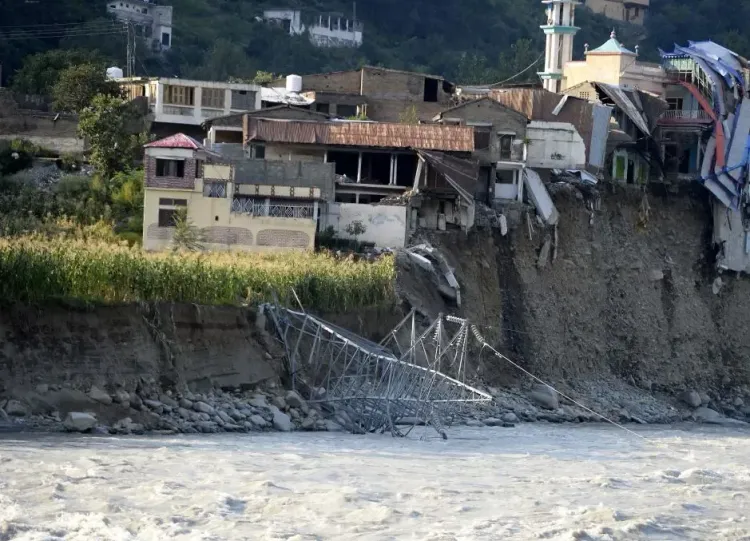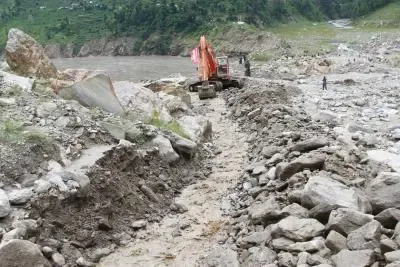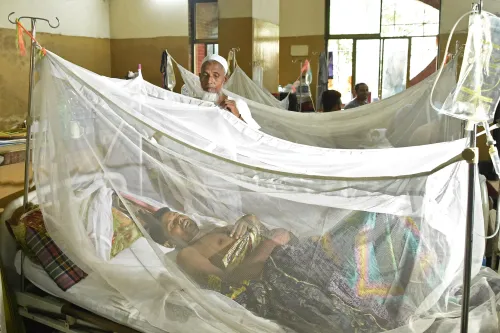What Is the Current Monsoon Death Toll in Punjab, Pakistan?

Synopsis
Key Takeaways
- The monsoon death toll in Punjab has reached 166.
- Sialkot experienced the highest rainfall at 78mm.
- Power outages affected over 120 feeders in Lahore.
- Authorities are on high alert for potential flooding.
- Residents are advised to remain vigilant during this critical period.
Lahore, Aug 10 (NationPress) The monsoon death toll in Punjab, Pakistan has tragically risen to 166 as of Saturday, following the reporting of two additional deaths in Sialkot and Jhelum. This comes as a new wave of heavy rainfall has impacted several cities in the region.
According to the Pakistan Meteorological Department (PMD), Sialkot experienced the most significant rainfall with 78mm, while Lahore received 43.4mm and Gujranwala saw 36.8mm. Other rainfall measurements included Chakwal (23mm), Attock (13.6mm), Mangla (12.2mm), Gujrat (10.6mm), Narowal (5mm), Rawalakot (4mm), Islamabad Airport (3.9mm), and Mandi Bahauddin (0.5mm), as reported by Dawn News.
While hot and humid weather is likely to persist across most of Punjab, the PMD has predicted isolated rain and thunderstorms for Sunday in northeastern areas of the province, including the Potohar region, Islamabad, upper Khyber Pakhtunkhwa, Kashmir, and nearby hilly regions.
Provincial officials reported, based on data from August 8, that there have been 164 deaths and 82 injuries related to monsoon-related incidents this season. Additionally, 121 livestock have died and 216 houses have been damaged throughout Punjab.
In Lahore, rainfall commenced at 1:30 p.m. and continued until 4:30 p.m.. The Water and Sanitation Agency (WASA) recorded the highest rainfall at Pani Wala Talab with 86mm, followed closely by Farrukhabad (85mm), Lakshmi Chowk (83mm), and Nishtar Town (81mm). Other impacted areas included Gulberg (60mm), Chowk Nakhuda (57mm), Iqbal Town (45mm), Johar Town (44mm), and Samanabad (43mm), while less significant rainfall occurred in Gulshan-i-Ravi, Qurtaba Chowk, Jail Road, and Tajpura.
Water accumulation has been noted in several areas, including Model Town, Kot Lakhpat, Peco Road, Township, Green Town, Factory Area, Muslim Town, and Garden Town. Flooding at the Nishtar Park Sports Complex resulted in the cancellation of the 'Independence Family Fun Race' scheduled for Saturday evening.
Power outages affected numerous regions of Lahore, with over 120 feeders tripping due to the rainfall.
The Provincial Disaster Management Authority (PDMA) has cautioned about potential low-level flooding in various rivers. According to the latest data, Tarbela Dam is at 96 percent capacity, with a water level of 1,546 feet, while Mangla Dam is 63 percent full at 1,205.25 feet.
Low-level flooding has been noted at Chashma Barrage on the Indus River. However, other major barrages such as Tarbela, Kalabagh, Taunsa, Guddu, Sukkur, and Kotri continue to show normal flow levels. The Jhelum, Sutlej, and Kabul Rivers are also flowing within expected parameters.
The Ravi River is experiencing minor flooding in the Basantar Nullah, but its main course remains unaffected. Fortunately, no flood risks have been reported from hill torrents in the Koh-i-Suleman range and Dera Ghazi Khan Division, which remain dry.
As the monsoon season reaches its peak, the PDMA’s Director General has urged the public to remain extremely cautious near water bodies. Section 144 has been enforced along rivers, canals, and streams, strictly prohibiting swimming or bathing to prevent accidents.
Authorities have confirmed that all necessary emergency arrangements are in place, and individuals residing in low-lying areas are advised to stay alert for further updates.









